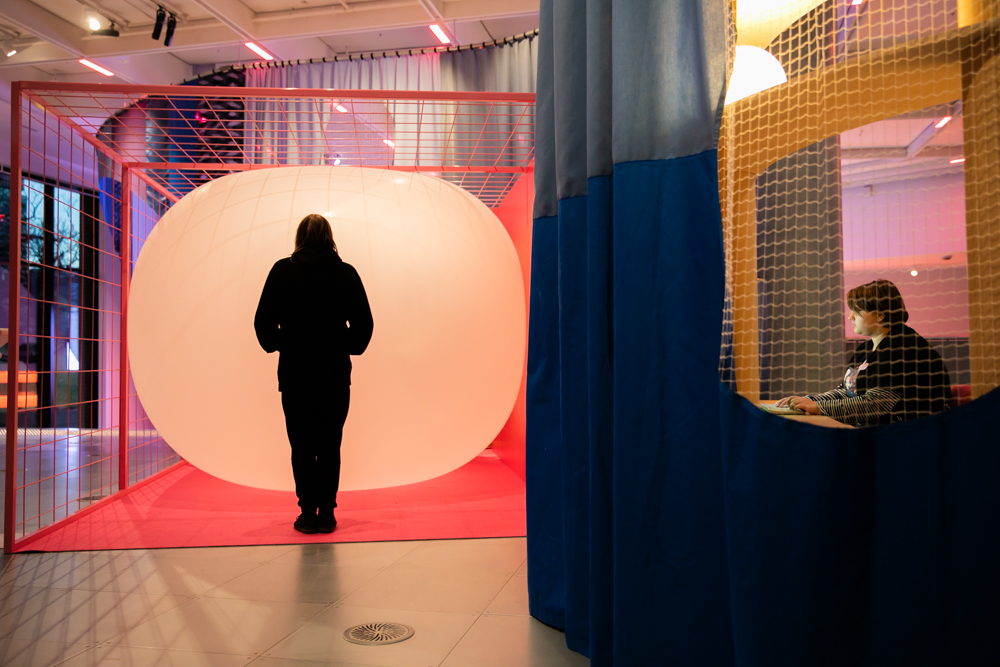
Arts & Culture
Your face is muted

Art can provoke, plague and preoccupy. But what can our interactions with art teach us about fully experiencing emotions in our everyday lives?
Published 19 July 2021
Art changes hearts and minds. It opens us to new ideas, challenges our biases and moves us on a deep emotional level. This puts artists at the coalface of revolution, stoking the feelings that fuel social change.
Science Gallery Melbourne’s MENTAL: Head Inside exhibition is designed to shift our perspective on what it means to survive and thrive in a crazy world.

Positing that every brain is unique, the exhibition aims to challenge stereotypes about mental health and open people to the reality of the full spectrum of mental health journeys.
Like all good art, MENTAL is designed to provoke, plague and preoccupy. This means you are likely to experience a range of emotions - positive as well as negative.
Rather than shying away from your feelings, our research in the Functions of Emotions in Everyday Life (FEEL) Research Lab champions the importance and benefits of fully experiencing emotions in our everyday lives.

Arts & Culture
Your face is muted
Here are three science-backed do’s and don’ts for staying open to the emotions that are provoked by art or our day-to-day lives.
Much of the art in MENTAL is expressly designed to make you feel uncomfortable. It may be tempting to avoid these unpleasant emotions. Like memories of your ex, you might want to put them in a box, buried at the bottom of your wardrobe, never to be opened again.
This reaction, called experiential avoidance, involves suppressing unpleasant thoughts, feelings, and bodily sensations.

Although it might be tempting to try and ignore our feelings, research shows experiential avoidance can have unforeseen consequences. In fact, there is some evidence that trying to avoid bad thoughts or emotions can make emotions stronger.
By trying to suppress our feelings, we might ironically be amplifying them instead.
Rather than shying away from unpleasant feelings, try to be aware of your emotions. Emotional awareness involves taking note of your thoughts, feelings and bodily sensations.

Arts & Culture
The microbiota and our mental health
As well as helping you to be present in the moment, awareness allows you to better regulate or modify your emotions.
After all, if you aren’t aware of how you’re feeling, there’s no way you can change it.
Being aware of your emotions is important, but awareness alone is not enough.
The next step in your journey is to understand how you feel; translating your feelings from a messy pile to an organised set.

One way to get a better understanding of your emotions is to label how you feel. Putting your feelings into words helps you better understand why you feel how you do.
For example, by articulating that an artwork makes you feel sad, you might realise that it tugs on a specific memory.
Research recommends that labels for your feelings should be as precise and specific as possible: that an artwork might make you feel sad, but not anxious, angry or disgusted.

Arts & Culture
Mental Health ≠ Wellbeing
Using these specific labels for your feelings helps you to manage them better, and is associated with a host of positive outcomes.
So how do you get better at labelling your feelings?
Some research suggests that mindfulness programs can help. But if you aren’t ready for that level of commitment, other work suggests simply monitoring how you feel can improve your labelling skills.
Keep track of how you are (and aren’t) feeling and try to refine the labels you use as you go.

Exhibitions like MENTAL might even help you practice these newfound labelling skills: some research suggests that those who engage more deeply and curiously with art use more fine-grained emotion labels.
So, you’ve allowed yourself to become aware of your emotions and have labelled precisely how you feel. What do you do next?
After noticing and labelling your feelings, you may realise that you don’t like how you feel. This realisation is common when encountering anything that challenges us, and is more likely to happen when we feel strong negative emotions.
It can be tempting to judge negative experiences as being ‘bad’ and something to move away from. But judgmental thoughts don’t serve us in the long term – being intolerant of distressing experiences is a hallmark of many psychological disorders.
The antidote to evaluating emotions harshly is to cultivate an attitude of nonjudgmental acceptance. A key dimension of mindfulness, acceptance involves neutrally observing emotions (and other mental experiences) as they arise and acknowledging that emotional distress is a natural part of the human condition.

It may seem surprising, but non-judgmentally accepting emotions rather than actively trying to change them helps to lower the intensity of felt emotion.
By accurately noticing how we feel without trying to change it, our emotions dissipate faster.
Of course, accepting emotion is easier said than done. What can you do if, like many people, your natural reaction is to chide yourself for getting angry or reject your own feelings of sadness?

Arts & Culture
Running on rainbows
Evidence is building that acceptance-based interventions – like acceptance and commitment therapy – can teach people to non-judgmentally accept their emotions.
So, if you want to learn how to accept your emotions without judgment, perhaps explore acceptance and commitment therapy or other related, mindfulness-based practices.
Try to be open to the emotions you feel – be aware, accurate and accepting.
Doing so will improve your relationship with art and your own wellbeing; it might even change the world, one he(art) at a time.
Part exhibition, part experiment, MENTAL is a welcoming place to confront societal bias and stereotypes about mental health. It features 21 works from local and international artists and research collaborators that explore different ways of being, surviving and connecting to each other. Opening in July 2021, book your free tickets now.
Banner: Mirror Ritual by Nina Rajcic and SensiLab: Installation view, MENTAL: Head Inside, Science Gallery Melbourne/Picture: Alan Weedon